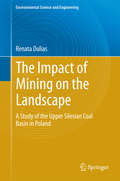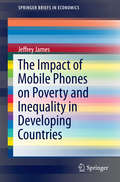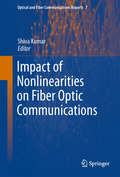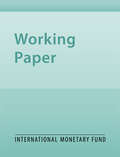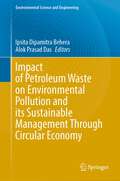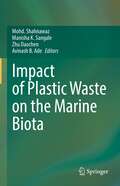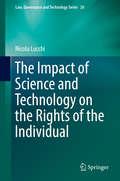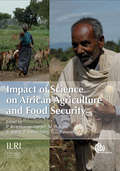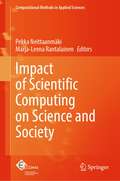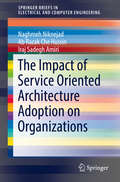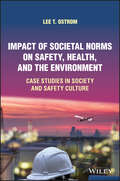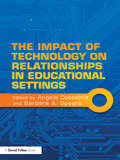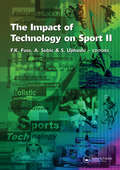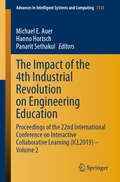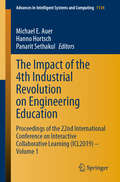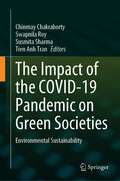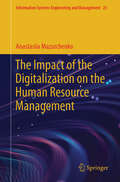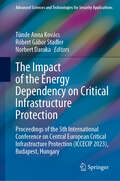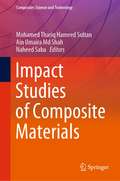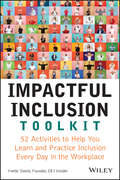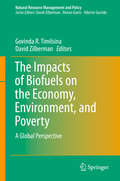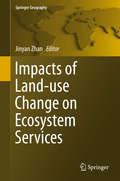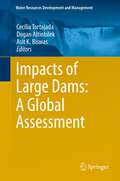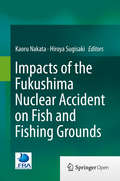- Table View
- List View
The Impact of Mining on the Landscape
by Renata DuliasThis book investigates the Upper Silesian Coal Basin (USCB), one of the oldest and largest mining areas not only in Poland but also in Europe. Using uniform research methods for the whole study area, it also provides a summary of the landscape transformations. Intensive extraction of hard coal, zinc and lead ores, stowing sands and rock resources have caused such extensive transformations of landscape that it can be considered a model anthropogenic relief. The book has three main focuses: 1) Identifying anthropogenic forms of relief related to mining activity and presenting them from a spatial, genetic and age perspective; 2) Determining the changes in the morphometric characteristics of relief and the conditions for matter circulation in open systems (drainage basins) and closed systems (land-locked basins) caused by the extraction of mineral resources; and 3) Estimating the extent of anthropogenic denudation using two different methods based on raw-material output and morphometric analysis. In Poland, no other mining area has undergone such intensive mining activity as the Upper Silesian Coal Basin during the last half century. Its share in the total extraction of mineral resources was as high as 32%. The total extraction of hard coal in the Upper Silesian Coal Basin from the mid-18th century until 2009 was the sixth largest in the world, and the permanent, regional effects of mining anthropopressure on the relief are among the most severe in the world. The anthropogenic denudation rate in the Upper Silesian Coal Basin, as well as the Ruhr Coal Basin (Ruhr District) and the Ostrava-Karvina Coal Basin, ranges from several dozen up to several hundred times higher than the rate of natural denudation, irrespective of the calculation method used. It would take the natural denudation processes tens of thousands of years to remove the same amount of material from the substratum as that removed through human mining activity.
The Impact of Mobile Phones on Poverty and Inequality in Developing Countries
by Jeffrey JamesThis book investigates at both the micro- and macroeconomic levels the impact of mobile phones on poverty and inequality in developing countries. To gauge the effects of mobile phones on these aspects, the author refers to the standard concept of technology adoption and also analyses the actual utilization of mobile phones as a means of communication and the degree to which they have supplanted fixed-line phones. Readers will learn why the substitution effect is stronger among poor than rich users and why the benefits of some mobile phone projects are confined to the local or village level, while in other projects the gains can be felt throughout the economy as a whole.
Impact of Nonlinearities on Fiber Optic Communications
by Shiva KumarThis book covers the recent progress in fiber-optic communication systems with a main focus on the impact of fiber nonlinearities on the system performance. Over the past few years, there has been significant progress in coherent communication systems mainly because of the advances in digital signal processing techniques. This has led to renewed interest in fiber linear and nonlinear impairments and techniques to mitigate them in electrical domain. In this book, the reader will find all the important topics of fiber optic communication systems in one place with in-depth coverage by the experts of each subtopics. Pioneers from each of the sub-topics have been invited to contribute. Each chapter will have a section on fundamentals, review of literature survey and the recent developments. The reader will benefit from this approach since many of the conference proceedings and journal articles mainly focus on the authors' research work without spending space on preliminaries.
The Impact of Oil-Related Income on the Equilibrium Real Exchange Rate in Syria
by Maher Hasan Jemma DridiA report from the International Monetary Fund.
Impact of Petroleum Waste on Environmental Pollution and its Sustainable Management Through Circular Economy (Environmental Science and Engineering)
by Ipsita Dipamitra Behera Alok Prasad DasThe purpose of this book is to discuss the challenges that have arisen due to petroleum hydrocarbon wastes, their harmful effects to the ecosystem, and limitations as well as improvement of current biological techniques’ use for management of petroleum hydrocarbon wastes. This book focuses on the role of advanced green engineering technologies for sustainable petroleum waste management in building an economic supportable society as a basic need of developing countries. The rapid economic growth achieved in last decade has been paralleled by an increase in global energy consumption resulting generation of massive amount of industrial wastes. Petroleum wastes release through spillages and leakage from underground tanks, steamers, unplugging of oil wells, and abandoned oil refinery sites that cause extensive contamination of surface soils, groundwater, seas, and ocean resulting in ecosystem damage. Apart from these, petroleum industries release a significant amount of hydrocarbon wastes during processing of crude oil. Improper waste management technique of these petroleum wastes may cause a serious effect toward the living beings. The presence of these hazardous wastes in the environment will make vulnerable conditions to the aquatic as well as terrestrial life. Till date, a number of conventional techniques have been implemented to treat these petroleum hazardous wastes, but biological treatment is more efficient among all on basics of economic and environmental point of view. Bioaugmentation, biostimulation, and combinatorial bioaugmentation and biostimulation waste management strategies are implemented to treat these wastes. In addition to these techniques, biocomposting/biopile, land treatment, and bio-slurry methods have also been employed to reduce the endanger effects of petroleum wastes. Integrating waste management through environmental sustainability and economic development is one of the prime milestones in the circular economy. There is an exigent necessity for developing countries to go ahead toward a circular economy for achieving its Sustainable Development Goals.
Impact of Plastic Waste on the Marine Biota
by Mohd. Shahnawaz Manisha K. Sangale Avinash B. Ade Zhu DaochenThis contributed volume focuses on the effects of macro, meso, micro, and nanoplastic waste on marine biota. It discusses the threats posed by plastic waste on the flora and fauna in the marine environment. This book will help in understanding different aspects of plastic waste generation, its transportation with different natural and anthropogenic ways, its accumulation at the seacoast, and its impact on marine biota. The book also suggests strategies for saving marine life from threats posed by plastic waste and presents methods to reduce its generation using different strategies. This book is of interest to teachers, researchers, climate change scientists, capacity builders, and policymakers. It also serves as additional reading material for undergraduate and postgraduate students of Ecology, Botany, and Environmental Sciences.
The Impact of Science and Technology on the Rights of the Individual
by Nicola LucchiThevolume is devoted to the relevant problems in the legal sphere, created andgenerated by recent advances in science and technology. In particular, itinvestigates a series of cutting-edge contemporary and controversialcase-studies wherescientific and technological issues intersect withindividual legal rights. The book addresses challenging topics at theintersection of communication technologies and biotech innovations such asfreedom of expression, right to health, knowledge production, Internet contentregulation, accessibility and freedom of scientific research.
Impact of Science on African Agriculture and Food Security
by P. Anandajayasekeram M. Rukani S. Babu F. Liebenberg C. L. KeswaniThe need for agricultural research resources in the developing world cannot be underestimated, but the availability of such resources is often poor due to lack of funding and investment. In order for Africa and other such developing countries to achieve productivity in agriculture - vital to food security, poverty reduction and sustainable management of natural resources - investment and policy development needs to be assessed. This book, a joint effort from IFPRI, ILRI and the Kellogg Foundation, explores the importance of impact assessment studies in Africa, and assembles important evidence to pave the way for further, much needed investment in agricultural research all over the developing world.
Impact of Scientific Computing on Science and Society (Computational Methods in Applied Sciences #58)
by Pekka Neittaanmäki Marja-Leena RantalainenThis book analyzes the impact of scientific computing in science and society over the coming decades. It presents advanced methods that can provide new possibilities to solve scientific problems and study important phenomena in society. The chapters cover Scientific computing as the third paradigm of science as well as the impact of scientific computing on natural sciences, environmental science, economics, social science, humanistic science, medicine, and engineering. Moreover, the book investigates scientific computing in high performance computing, quantum computing, and artificial intelligence environment and what it will be like in the 2030s and 2040s.
The Impact of Service Oriented Architecture Adoption on Organizations (SpringerBriefs in Electrical and Computer Engineering)
by Naghmeh Niknejad Ab Razak Hussin Iraj Sadegh AmiriThis book describes Service-Oriented Architecture (SOA) and the significant factors which affect its adoption, such as governance, strategy, complexity, Return on Investment (ROI), business and IT alignment, culture and communication, costs, and security. The study on which this book is based, involved a quantitative analysis to investigate the influential factors for adopting SOA, paving the way to further research in the field.
Impact of Societal Norms on Safety, Health, and the Environment: Case Studies in Society and Safety Culture
by Lee T. OstromA compelling exploration of how social norms and commercial culture impact the safety of organizational operations In Impact of Societal Norms on Safety, Health, and the Environment: Case Studies in Society and Safety Culture, distinguished engineer Dr. Lee T. Ostrom delivers an authoritative treatment of the cultural, social, and human factors of safety cultures and issues in the workplace. The book offers readers compelling discussions of how those factors impact organizational operations and what contributes to making those impacts beneficial or detrimental. The author provides numerous real-world case studies from North America and Europe that are relevant to a global audience, highlighting the central message of the book: that an organization that views its safety culture as unimportant could be setting itself up for a significant workplace accident. Readers will also find: A thorough introduction to social norms that impact how commercial organizations treat issues of safety and workplace health In-depth safety culture case studies from North America and Europe Comprehensive explorations of how peoples&’ perceptions of hazards impact workplace operations and the daily lives of employees Fulsome discussions of the effect of societal attitudes on workplace health and safetyPerfect for industrial and safety managers, safety coordinators, and safety representatives, Impact of Societal Norms on Safety, Health, and the Environment will also earn a place in the libraries of industrial hygienists, ergonomic program coordinators, and HR professionals.
The Impact of Technology on Relationships in Educational Settings
by Barbara A. Spears Angela CostabileAs the linguistic, cognitive and social elements of our lives are transformed by new and emerging technologies, educational settings are also challenged to respond to the issues that have arisen as a consequence. This book focuses on that challenge: using psychological theory as a lens to highlight the positive uses of new technologies in relationships and educational settings, and to advocate technological learning opportunities and social support where the misuse and abuse of ICT occurs. The Impact of Technology on Relationships in Educational Settings sets out to explore the role of ICTs in relationship forming, social networking and social relationships within our schools and has grown out of the European Cooperation in Science and Technology (COST); Action on cyberbullying, involving 28 participating countries, and two non-COST countries, of which Australia is one. This cutting edge international text offers cross-cultural, psychological perspectives on the positive uses of new and emerging technologies to improve social relationships and examples of best practice to prevent virtual bullying. This comes at a time when much of the focus in current writings has been on the more negative aspects which have emerged as new technologies evolved: cyberbullying, cyber-aggression and cybersafety concerns. This text is ideally suited to researchers and practiitioners in the fields of Educational and developmental psychology, as well as those specialising in educational technology and the sociology of education.
The Impact of Technology on Sport II
by F. K. Fuss A. Subic S. UjihashiSport technology has to be seen from the holistic, as well as inter- and transdisciplinary point of view. Product development requires close collaboration between engineers, athletes, sports scientists, and business managers. It requires an in-depth understanding of engineering disciplines, life and sport sciences, as well as economics. The Impact
The Impact of the 4th Industrial Revolution on Engineering Education: Proceedings of the 22nd International Conference on Interactive Collaborative Learning (ICL2019) – Volume 2 (Advances in Intelligent Systems and Computing #1135)
by Michael E. Auer Hanno Hortsch Panarit SethakulThis book gathers papers presented at the 22nd International Conference on Interactive Collaborative Learning (ICL2019), which was held in Bangkok, Thailand, from 25 to 27 September 2019. Covering various fields of e-learning and distance learning, course and curriculum development, knowledge management and learning, real-world learning experiences, evaluation and outcomes assessment, computer-aided language learning, vocational education development and technical teacher training, the contributions focus on innovative ways in which higher education can respond to the real-world challenges related to the current transformation in the development of education. Since it was established, in 1998, the ICL conference has been devoted to new approaches in learning with a focus on collaborative learning. Today, it is a forum for sharing trends and research findings as well as presenting practical experiences in learning and engineering pedagogy. The book appeals to policymakers, academics, educators, researchers in pedagogy and learning theory, school teachers, and other professionals in the learning industry, and further and continuing education.
The Impact of the 4th Industrial Revolution on Engineering Education: Proceedings of the 22nd International Conference on Interactive Collaborative Learning (ICL2019) – Volume 1 (Advances in Intelligent Systems and Computing #1134)
by Michael E. Auer Hanno Hortsch Panarit SethakulThis book gathers papers presented at the 22nd International Conference on Interactive Collaborative Learning (ICL2019), which was held in Bangkok, Thailand, from 25 to 27 September 2019. Covering various fields of interactive and collaborative learning, new learning models and applications, research in engineering pedagogy and project-based learning, the contributions focus on innovative ways in which higher education can respond to the real-world challenges related to the current transformation in the development of education. Since it was established, in 1998, the ICL conference has been devoted to new approaches in learning with a focus on collaborative learning. Today, it is a forum for sharing trends and research findings as well as presenting practical experiences in learning and engineering pedagogy. The book appeals to policymakers, academics, educators, researchers in pedagogy and learning theory, school teachers, and other professionals in the learning industry, and further and continuing education.
The Impact of the COVID-19 Pandemic on Green Societies: Environmental Sustainability
by Chinmay Chakraborty Swapnila Roy Susmita Sharma Tien Anh TranThis book covers the sustainability issues of a green environment towards economics and society in terms of alteration in industrial pollution levels, effect of reduced carbon emissions, changes in water bodies characteristics with respect to heavy metal contamination, monitoring of associated impact with respect to ecology and biodiversity, impact of reduced noise levels and air quality influences on human health, handling and management of biomedical waste. According to WHO, 80% of people living in urban areas are exposed to air exceeding safe limits. The advent of "sustainability‟ in development science has led planners to apply evolving notions of "sustainability‟ to the contemporary debate over how cities and regions should be revitalized, redeveloped, and reformed. Market allocation of resources, sustained levels of growth and consumption, an assumption that natural resources are unlimited and a belief that economic growth will „trickle down‟ to the poor have been its hallmarks. The recent advance technology helps to promote green and clean modern societies continuously. The Internet of things will be playing an important role in the upcoming years in environment protection and sustainable development. There is a focus on paradigm shift in the sustainable development for the green environment during the period of isolation of COVID-19. This is the moment for the mobilization against the climate crisis. The sudden fall in pollutants and subsequent blue skies signifies a dramatic shift for India and also other affected countries during this period. Fighting climate change requires a collaborative approach between all spheres of society unlike the former. It must heavily redirect resources towards local, sustainable activities, including education, health, sustainable agriculture and circular management of resources. The impact of COVID-19 pandemic which has resulted in the dramatic change in the different aspects of the environment. The global lockdown has led to a rejuvenation of nature, ecosystems, biodiversity. Even urban environments are discovering a degree of peace and serenity, which led to decrease in greenhouse gas emission.
The Impact of the Digitalization on the Human Resource Management (Information Systems Engineering and Management #25)
by Anastasiia MazurchenkoThis book is strongly recommended for L&D professionals, HR managers, senior managers, and company owners who want to adapt their employees' training and skills development to the changing requirements of digitalization and technological progress, considering the specifics of the sector in which their organizations operate. It is unique in that it compares the views of employers and employees on digitalization and the development of digital competencies and skills and highlights the need to align them as part of implementing a long-term HR development strategy in an organization. The book features statistical hypothesis testing and links to the case studies, and it covers such areas as the historical development of digitalization, advantages, and disadvantages of technologies in HR management, the role of competency models, and organizational training in conditions of the Fourth and Fifths Industrial revolutions. The book also explores how employees' digital skill levels depend on age and career longevity and how much the level of digital readiness of organizations is affected by labor market trends and the impact of the COVID-19 pandemic. Taking into account practical recommendations and issues to consider, it emphasizes the need to update competency models, support a culture of continuous organizational training and knowledge sharing, and extend an organization's digital infrastructure to retain competitive human resources in the dynamic digital age. Readers will receive a comprehensive understanding of digitalization in human resource management and how it influences competency requirements for employees in different sectors in the international context.
The Impact of the Energy Dependency on Critical Infrastructure Protection: Proceedings of the 5th International Conference on Central European Critical Infrastructure Protection (ICCECIP 2023), Budapest, Hungary (Advanced Sciences and Technologies for Security Applications)
by Tünde Anna Kovács Róbert Gábor Stadler Norbert DarukaThis book presents cutting-edge research on the impact of energy dependence and strategies to mitigate it. As a crucial component of critical infrastructure, energy security is a top priority for nations worldwide. The protection of this infrastructure, along with the latest research tools and methodologies, is of significant interest to both policymakers and industry leaders. The book delves into two primary areas of research: cybersecurity and physical security, summarizing the latest findings in these critical fields. The papers in this volume offer valuable insights for both academic and industrial audiences, addressing the pressing challenges of energy security. Energy is integral to every aspect of our daily lives. Our comfort, as well as our safety, hinges on the uninterrupted supply of energy. Recent global events, particularly the Russian-Ukrainian war, have underscored the vulnerability of nations lacking sufficient energy resources. Europe's energy supply has been severely disrupted by sanctions, highlighting the need for energy resilience. However, this crisis has also accelerated the adoption of renewable energy sources, marking a pivotal shift towards sustainable energy solutions.
Impact Studies of Composite Materials (Composites Science and Technology)
by Mohamed Thariq Hameed Sultan Ain Umaira Md Shah Naheed SabaThis book discusses the impact of different range of velocities (low, high, ballistic and hyper-velocity impact) on composites. Presented through experimental and numerical analysis, the book goes beyond impact event analysis and also covers the after-impact phenomena, including flexural and compression and damage analysis through destructive and non-destructive evaluations. The analyses presented from either experimental or numerical simulations are composed of micro and macrographs images, illustrations, tables and figures with inclusive discussions and supportive evidences from recent studies on composites. This book also highlights the potential applications of composites through the lens of their impact properties, in different industries such as automotive and defence applications. Generally, this book benefits wider range of readers including the industrial practitioners, researchers, lecturer and students, who are working in the fields related to impact and damage analysis, including the structural health monitoring of composites, either experimentally or numerically.
Impactful Inclusion Toolkit: 52 Activities to Help You Learn and Practice Inclusion Every Day in the Workplace
by Yvette SteelePractical, hands-on strategies to increase inclusion, diversity, and equity in your workplace In Impactful Inclusion Toolkit: 52 Activities to Help You Learn and Practice Inclusion Every Day in the Workplace, accomplished diversity, equity, and inclusion (DEI) strategist and leader Yvette Steele delivers a collection of practical and hands-on exercises that encourage and promote inclusion in the workplace. The exercises emphasize the development of key inclusive behaviors, including self-knowledge, connecting with others, creating new habits, and experiencing other cultures. In the book, you&’ll find: 52 behaviors to practice during the year that will empower you to be more inclusive in the real world Concrete instructions regarding how to become more inclusive, rather than just high-level information about inclusivity generally Actionable strategies to help drive change in your organization and manage the discomfort that sometimes exists around DEI issues An effective and practical resource for anyone who wants to be more inclusive. Frontline and knowledge workers can empower themselves to drive change with weekly activities and resources. DEI and HR professionals, company founders, owners, managers, and other business leaders can better support staff on their inclusion journey. The Impactful Inclusion Toolkit is an essential addition to DEI strategies of any organization whether they are active or aspire to be more inclusive.
The Impacts of Biofuels on the Economy, Environment, and Poverty
by Govinda R. Timilsina David ZilbermanInterest in biofuels began with oil shocks in the 1970's, but the more rapid development and consumption of biofuel industry in recent years has been primarily driven by mandates, subsidies, climate change concerns, emissions targets and energy security. From 2004 to 2006, fuel ethanol grew by 26% and biodiesel grew by 172%. As biofuel production continues to expand, investments in capacity expansion and research and development have been made. The 2008 food crisis emphasized the need to re-examine biofuel consequences. Biofuels remain an important renewable energy resource to substitute for fossil fuels, particularly in the transportation sector, yet biofuels' success is still uncertain. The future of biofuels in the energy supply mix relies on mitigating potential and improving the environmental gains. This book brings together leading authorities on biofuel from the World Bank to examine all of the impacts of biofuel (economic, social, environmental) within a unified framework and in a global perspective, making it of interest to academics in agricultural and environmental economics as well as industry and policy-makers.
Impacts of Land-use Change on Ecosystem Services
by Jinyan ZhanThis book aims to systematically elaborate how land-use change directly or indirectly exerts impacts on the ability of ecosystems to provide services for human society. The relationship between land use, ecosystem services and human well-being is a hot topic, and there have been some important achievements in this field, but its continuing growth means that it warrants further research. The unique viewpoint, the scientific analysis methods and the precise language of this book make it not only a valuable guide for professors conducting research, but also a reference resource to help governments make decisions on relevant policies. Prof. Jinyan Zhan is an associate professor at the School of Environment, Beijing Normal University, China.
Impacts of Large Dams: A Global Assessment
by Cecilia Tortajada Dogan Altinbilek Asit K. BiswasOne of the most controversial issues of the water sector in recent years has been the impacts of large dams. Proponents have claimed that such structures are essential to meet the increasing water demands of the world and that their overall societal benefits far outweight the costs. In contrast, the opponents claim that social and environmental costs of large dams far exceed their benefits, and that the era of construction of large dams is over. A major reason as to why there is no consensus on the overall benefits of large dams is because objective, authoritative and comprehensive evaluations of their impacts, especially ten or more years after their construction, are conspicuous by their absence. This book debates impartially, comprehensively and objectively, the positive and negative impacts of large dams based on facts, figures and authoritative analyses. These in-depth case studies are expected to promote a healthy and balanced debate on the needs, impacts and relevance of large dams, with case studies from Africa, Asia, Australia, Europe and Latin America.
Impacts of Selenium on the Biogeochemical Cycles of Mercury in Terrestrial Ecosystems in Mercury Mining Areas
by Hua ZhangFrom a new perspective, namely focusing on the interaction of selenium and mercury, this thesis provides new insights into traditional research on biogeochemical cycles of mercury in soil-plant interaction and associated human exposure and risks. The subject of this thesis is both valuable and timely, providing essential information not only on selenium-mercury interaction in the soil-plant system but also on how to assess the combined benefits and risk of co-exposure to mercury and selenium. This work also sheds light on future aspects regarding prevention, remediation and risk management for environmental mercury contamination. Presenting high-quality papers published in leading international SCI journals such as Environmental Health Perspectives and Environmental Science & Technology and having been recognized with the Special Award of Presidential Scholarship Award and Excellent Doctoral Dissertations Prize of the Chinese Academy of Sciences (CAS), this thesis offers a valuable resource for scientific communities, policy-makers and non-experts who are interested in this field. Dr. Hua Zhang works at the Norwegian Institute for Water Research (NIVA), Oslo, Norway.
Impacts of the Fukushima Nuclear Accident on Fish and Fishing Grounds
by Kaoru Nakata Hiroya SugisakiThis book presents the results from the Japanese Fisheries Research Agency's 3-year intensive monitoring of radionuclides in a variety of fish, plankton, benthos, and their living environments after the Fukushima Daiichi Nuclear Power Plant (FNPP) accident in March 2011. The book reveals the dynamics of contamination processes in marine and freshwater fish, mediated by the contamination of water, sediments, and food organisms; it also clarifies the mechanisms by which large variations in the level of contamination occurs among individual fish. Most importantly, the book includes a large amount of original measurement data collected in situ and for the first time assesses diffusion of radiocesium across the Pacific using both in situ data and a numerical simulation model. Also introduced are several new approaches to evaluate the impact of the release of radionuclides, including the measurement of radiation emission from an otolith section to identify the main period of contamination in fish. The FNPP accident represents a rare instance where the environmental radioactivity level was elevated steeply through atmospheric fallout and direct discharge of radioactive water into the sea over a short period of time. Replete with precise scientific data, this book will serve as an important resource for research in fields such as fishery science, oceanography, ecology, and environmentology, and also as a solid basis for protecting fisheries from damage resulting from harmful rumors among the general public.
